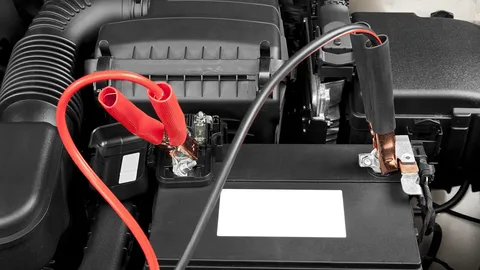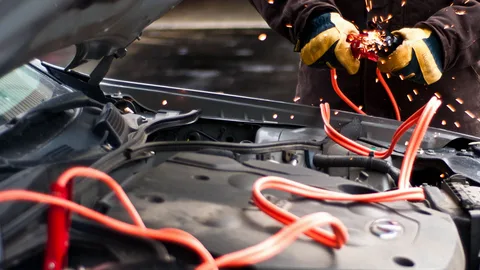If your car has not power at all even with jumper cables, not even with jumper cables, you may be in for a long night. Unless, of course, you’re a bit of a DIY expert. In that case, this blog post is for you! We’ll show you how to diagnose and fix the problem so you can be back on the road in no time.
Why Your Car Might Not Have Power
Contents
There are a few reasons why your car might not have power, even with jumper cables. It could be that your battery is dead, your alternator is not working properly, or there could be an issue with your electrical system. If your battery is dead, you will need to replace it.
If your alternator is not working properly, you will need to have it repaired or replaced. If there is an issue with your electrical system, you will need to have it repaired by a qualified mechanic.
How to Jump-Start Your Car
If your car has a dead battery, you may be able to jump-start it by using a set of jumper cables and another car with a good battery. Follow these steps to safely jump-start your car:
- Park the working car close to the disabled car, but do not allow the vehicles to touch each other.
- Shut off all lights and accessories in both cars.
- Locate the positive (+) terminal on the dead battery, and the negative (-) terminal. The terminals are usually marked with red and black, respectively.
- Clip one end of the red jumper cable to the positive terminal on the dead battery, and clip the other end of the red cable to the positive terminal on the working battery.
- Clip one end of the black jumper cable to the negative terminal on the working battery, and clip the other end of black cable to an unpainted metal surface on the disabled car—not to the dead battery’s negative terminal, which can create a spark.
- Start the working car, and let it run for several minutes before starting the disabled car. Once you start your disabled car, drive it for at least 15 minutes before turning it off so you can recharge your battery.
What to Do if Your Car Still Won’t Start
If your car has been having trouble starting, or if it has been stalling frequently, there are a few things you can check before taking it to a mechanic.
First, make sure that the battery is properly charged. If it is low, you can try jump-starting the car has not power at all even with jumper cables. If the battery is old, it may need to be replaced.

Another possibility is that the starter motor is not working properly. This can be diagnosed by listening for a clicking noise when you turn the key in the ignition. If you hear this noise, it may be necessary to replace the starter motor.
Another possibility is that there is something wrong with the fuel system. This could be due to a problem with the fuel pump, a blockage in the fuel line, or a problem with the carburetor. These problems will need to be diagnosed and repaired by a mechanic.
When to See a Mechanic
If you’ve jump-started your car has not power at all even with jumper cables and it still won’t start, there are a few things you can check before taking it to a mechanic. Make sure all of the connections are snug and that the jumper cables are properly connected to the battery. If the car still won’t start, it’s possible that the battery is too damaged to be revived with a jump start. In this case, you’ll need to replace the battery.
Common Causes of Power Loss in Cars
One of the most common causes of power loss in cars is a dead battery. If your car won’t start, even with jumper cables, it’s likely that your battery is dead.
Other common causes of power loss include loose or corroded battery terminals, and a faulty alternator. If you’re not sure what’s causing your car to lose power, take it to a mechanic for diagnosis.
How to Prevent Power Loss in Your Car
Your car’s battery is what provides the power to start your engine. It also helps run some of your car has not power at all electrical accessories, like the headlights, radio, and windshield wipers. If your battery dies, you’ll need a jump start to get it going again.

There are several things that can cause your battery to die, such as leaving your headlights on for too long, or running too many electrical accessories at once. If you live in a cold climate, the cold weather can also affect your battery’s performance.
Here are some tips to help prevent power loss in your car:
- Make sure your battery is properly charged. A dead battery is the most common cause of power loss in a car has not power at all.
- Keep your battery clean. Corrosion on the terminals can prevent juice from flowing freely from the battery to the starter.
- Don’t overuse electrical accessories. Things like heated seats and stereos can draw a lot of power from the battery. If you’re using these accessories frequently, make sure to turn them off when you’re not using them so that they don’t drain the battery.
- In cold weather, try to keep yourcar has not power at all cabin warm. This will help prevent the battery from freezing and losing power.
What to Do if Your Car Battery Dies
It happens to everyone at some point: you go to start your car has not power at all, and it won’t start. If you find yourself in this situation, there are a few things you can do.
First, check the battery. If it’s dead, you’ll need to jump start it. To do this, you’ll need jumper cables and another car has not power at all with a working battery. Once you have jumper cables, connect the positive cable (red) to the positive terminal on your dead battery, and then connect the other end of the positive cable to the positive terminal on the working battery.
Next, connect the negative cable (black) to the negative terminal on the working battery, and then connect the other end of the negative cable to a metal ground on your car (such as a bolt on the engine block). Finally, start the working car, and then try starting your car. If it starts, disconnect the cables in reverse order (negative first, then positive).
If your car has no powered at all and won’t start after jumping it, there might be another problem such as a faulty starter or alternator. In this case, you’ll need to have your car not power at all towed to a mechanic for repairs.
How to Jump Start a Dead Car Battery
Jumper cables are the most common way to jump-start a dead car battery. If you don’t have jumper cables, you can also use a power pack.
First, make sure that the power pack is turned off. Next, attach the positive (red) clamp to the positive terminal on the dead battery. Then, attach the negative (black) clamp to the negative terminal on the live battery. Finally, turn on the power pack and start the car.
